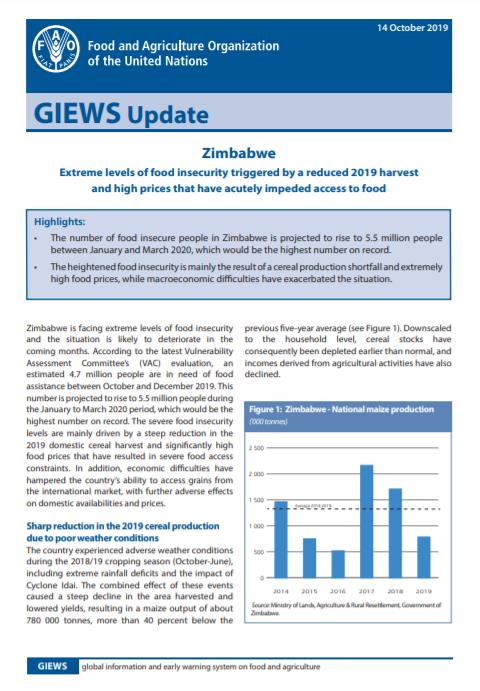
GIEWS Update - Zimbabwe, 14 October 2019
14/10/2019
The number of food insecure people in Zimbabwe is projected to rise to 5.5 million people between January and March 2020, which would be the highest number on record. The heightened food insecurity is mainly the result of a cereal production shortfall and extremely high food prices, while macroeconomic difficulties have exacerbated the situation.
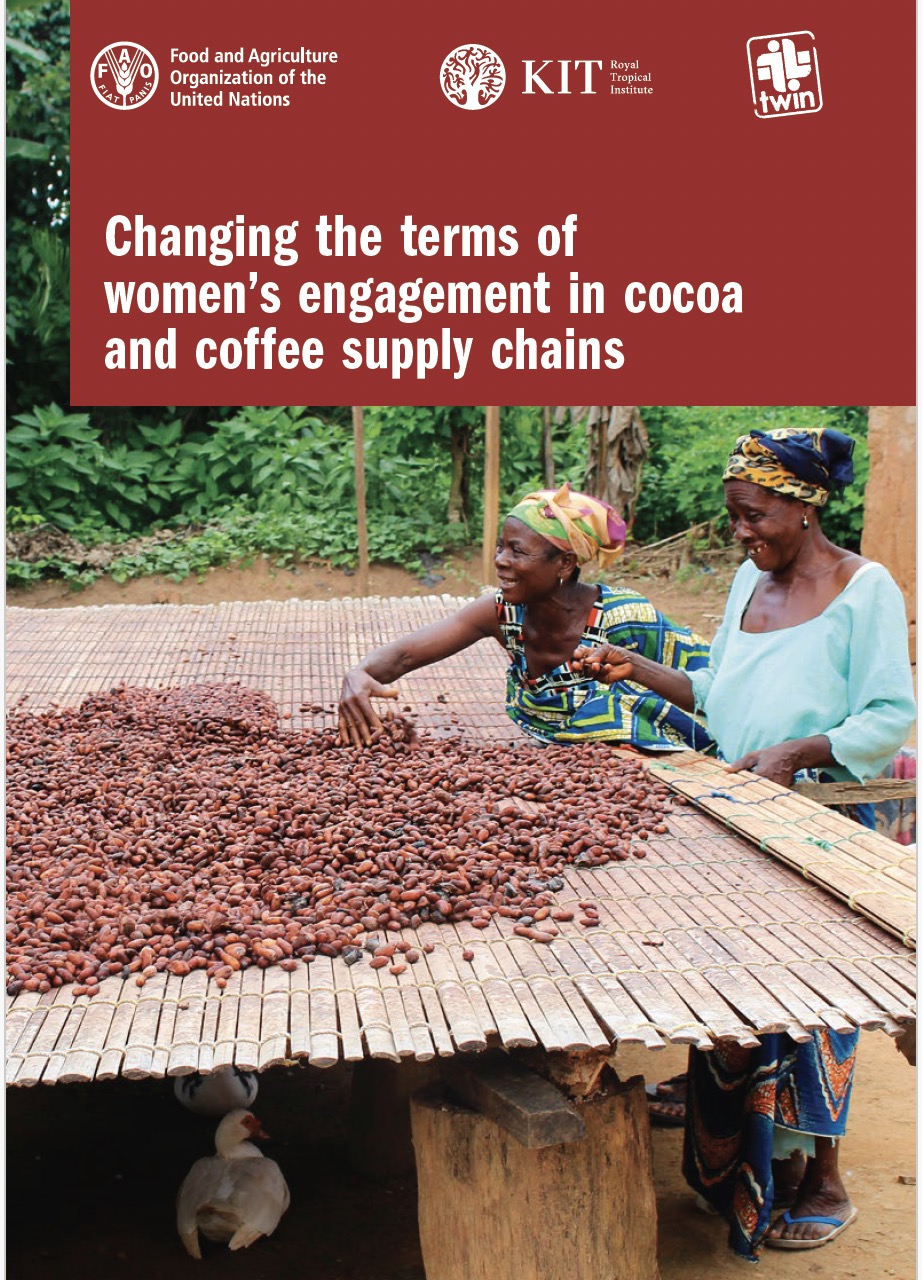
Changing the terms of women's engagement in cocoa and coffee supply chains
10/10/2019
In this report, FAO, Twin, KIT and other case holders take a close look at gender inequalities in the cocoa and coffee sectors, and their underlying causes. The included case studies are structured around four themes including: women’s participation and leadership in producer organisations, women’s access to land, the household approach and innovations in extension services. The report also explores how to address inequalities systematically and how to bring the solutions to scale.
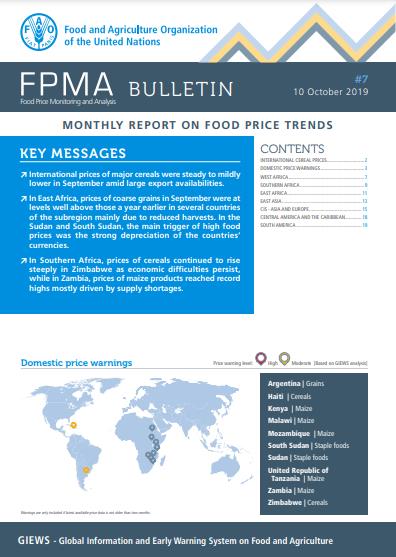
Food Price Monitoring and Analysis (FPMA) Bulletin #7, 10 October 19
10/10/2019
International prices of major cereals were steady to mildly lower in September amid large export availabilities. In East Africa, prices of coarse grains in September were at levels well above those a year earlier in several countries of the subregion mainly due to reduced harvests. In the Sudan and South Sudan, the main trigger of high food prices was the strong depreciation of the countries’ currencies. In Southern Africa, prices of cereals continued to rise steeply in Zimbabwe as economic difficulties persist, while in Zambia, prices of maize products reached record highs mostly driven by supply shortages.
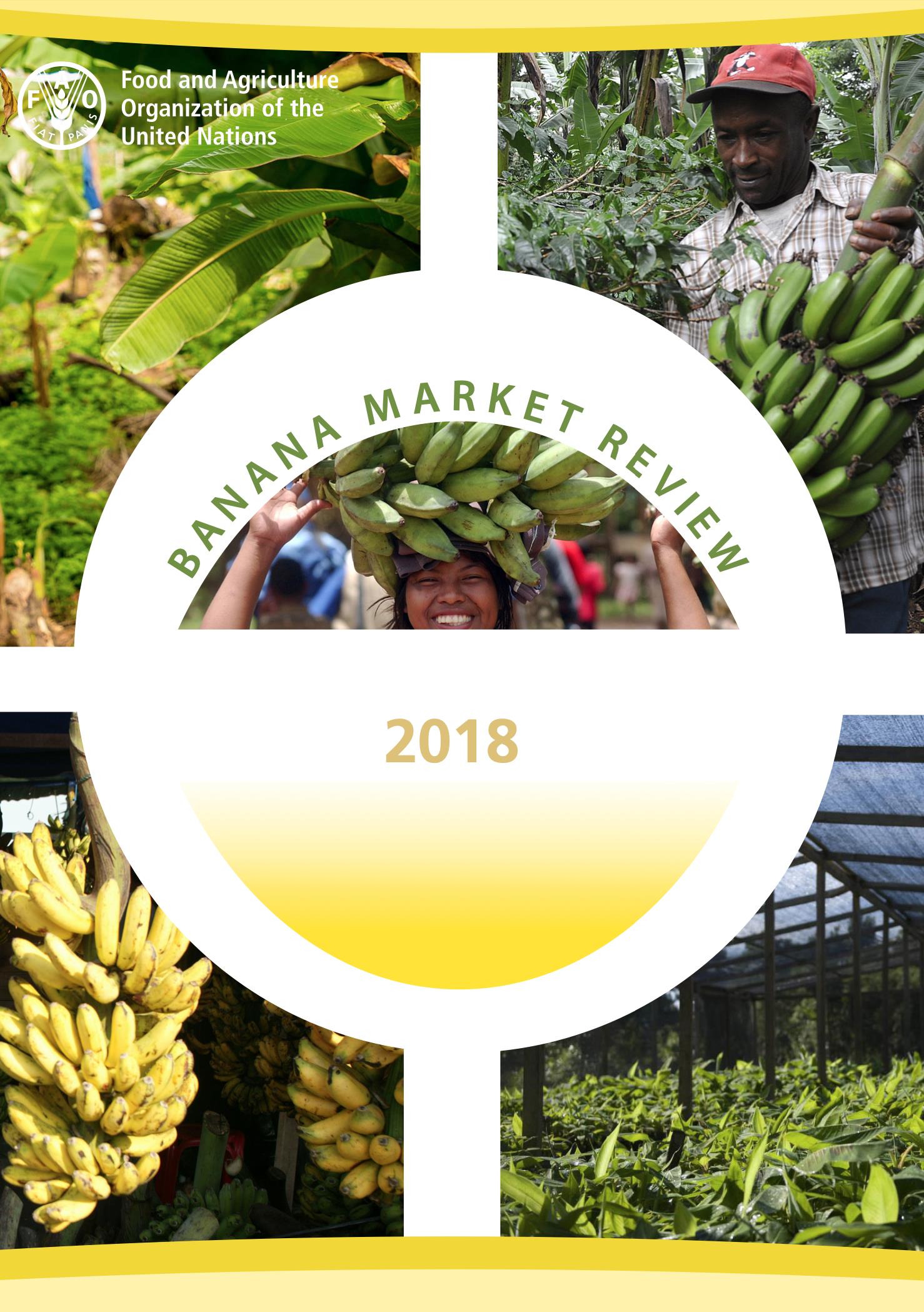
Banana Market review 2018
09/10/2019
A comprehensive analysis of production, trade, and prices of bananas.
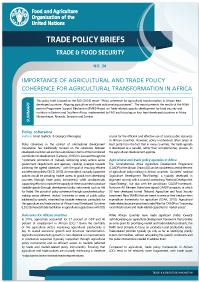
No. 34 Importance of agriculture and trade policy coherence for agricultural transformation in Africa
08/10/2019
This policy brief is based on the FAO (2018) report “Policy coherence for agricultural transformation in African least developed countries: Aligning agriculture and trade policymaking processes”. The report presents the results of the Multi-partner Programme Support Mechanism (FMM) Project on Trade related capacity development for food security and nutrition in Eastern and Southern Africa, implemented by FAO and focusing on four least developed countries in Africa: Mozambique, Rwanda, Tanzania and Zambia.
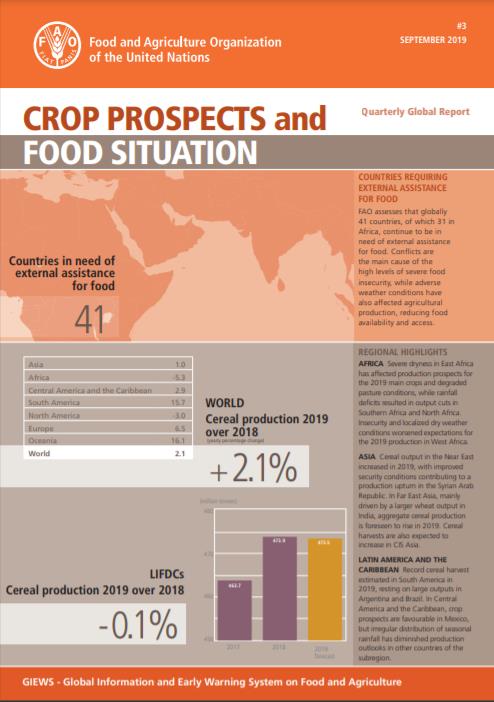
Crop Prospects and Food Situation - Quarterly Global Report, No. 3, September 2019
19/09/2019
FAO assesses that globally 41 countries, of which 31 in Africa, continue to be in need of external assistance for food. Conflicts are the main cause of the high levels of severe food insecurity, while adverse weather conditions have also affected agricultural production, reducing food availability and access.
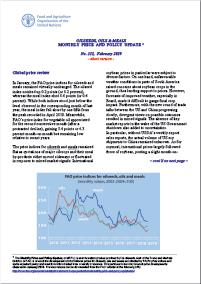
Oilseeds, Oils and Meals. Monthly Price and Policy Update No.115, February 2019
13/09/2019
In January, the FAO price indices for oilseeds and meals remained virtually unchanged. The oilseed index notched up 0.2 points (or 0.2 percent), whereas the meal index shed 0.6 points (or 0.4 percent). While both indices stood just below the level observed in the corresponding month of last year, the meal index fell short by one fifth from the peak recorded in April 2018. Meanwhile, FAO’s price index for vegetable oil appreciated for the second consecutive month (after a protracted decline), gaining 5.4 points or 4.3 percent month-on-month but remaining low relative to recent years.
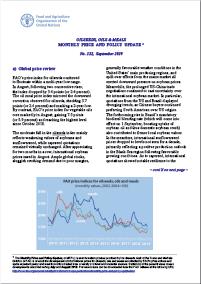
Oilseeds, Oils and Meals. Monthly Price and Policy Update No.122, September 2019
13/09/2019
FAO’s price index for oilseeds continued to fluctuate within a multi-year low range. In August, following two consecutive rises, the index dropped by 3.4 points (or 2.4 percent). The oil meal price index mirrored the downward correction observed for oilseeds, shedding 3.7 points (or 2.4 percent) and marking a 2-year low. By contrast, FAO’s price index for vegetable oils rose markedly in August, gaining 7.5 points (or 5.9 percent) and reaching the highest level since October 2018.
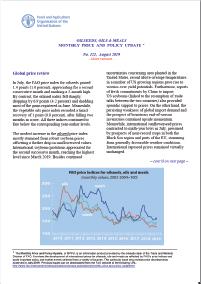
Oilseeds, Oils and Meals. Monthly Price and Policy Update No.121, August 2019
13/09/2019
In July, the FAO price index for oilseeds gained 1.4 points (1.0 percent), appreciating for a second consecutive month and marking a 5-month high. By contrast, the oilmeal index fell sharply, dropping by 6.9 points (4.2 percent) and shedding most of the gains registered in June. Meanwhile, the vegetable oils price index recorded a timid recovery of 1 point (0.8 percent), after falling two months in a row. All three indices continued to fare below the corresponding year-earlier levels.
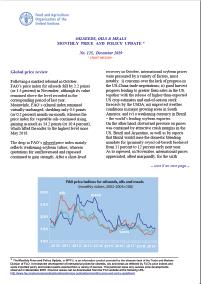
Oilseeds, Oils and Meals. Monthly Price and Policy Update No.125, December 2019
13/09/2019
Following a marked rebound in October, FAO’s price index for oilseeds fell by 2.2 points (or 1.5 percent) in November, although its value remained above the level recorded in the corresponding period of last year. Meanwhile, FAO’s oilmeal index remained virtually unchanged, shedding only 0.3 points (or 0.2 percent) month-on-month, whereas the price index for vegetable oils continued rising, gaining as much as 14.2 points (or 10.4 percent), which lifted the index to the highest level since May 2018.
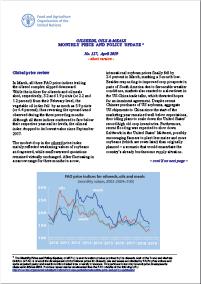
Oilseeds, Oils and Meals. Monthly Price and Policy Update No.117, April 2019
13/09/2019
In March, all three FAO price indices trailing the oilseed complex slipped downward. While the indices for oilseeds and oilmeals shed, respectively, 3.2 and 1.9 points (or 2.2 and 1.2 percent) from their February level, the vegetable oil index fell by as much as 5.9 points (or 4.4 percent), thus reversing the upward trend observed during the three preceding months. Although all three indices continued to fare below their respective year-earlier levels, the oilmeal index dropped to its lowest value since September 2017.
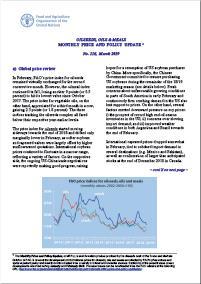
Oilseeds, Oils and Meals. Monthly Price and Policy Update No.116, March 2019
13/09/2019
In February, FAO’s price index for oilseeds remained virtually unchanged for the second consecutive month. However, the oilmeal index continued its fall, losing another 9 points (or 5.5 percent) to hit its lowest value since October 2017. The price index for vegetable oils, on the other hand, appreciated for a third month in a row, gaining 2.3 points (or 1.8 percent). The three indices tracking the oilseeds complex all fared below their respective year-earlier levels.
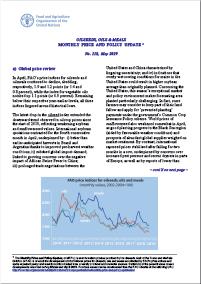
Oilseeds, Oils and Meals. Monthly Price and Policy Update No.118, May 2019
13/09/2019
In April, FAO’s price indices for oilseeds and oilmeals continued to decline, shedding, respectively, 1.9 and 1.2 points (or 1.4 and 0.8 percent), while the index for vegetable oils notched up 1.1 points (or 0.9 percent). Remaining below their respective year-earlier levels, all three indices lingered around historical lows.
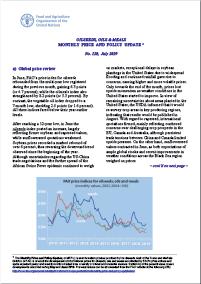
Oilseeds, Oils and Meals. Monthly Price and Policy Update No.120, July 2019
13/09/2019
In June, FAO’s price index for oilseeds rebounded from the multi-year low registered during the previous month, gaining 6.3 points (or 4.7 percent), while the oilmeals index also strengthened by 8.2 points (or 5.3 percent). By contrast, the vegetable oil index dropped to a 7-month low, shedding 2.0 points (or 1.6 percent). All three indices fared below their year-earlier levels.
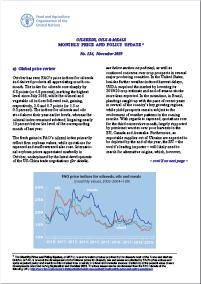
Oilseeds, Oils and Meals. Monthly Price and Policy Update No.124, November 2019
13/09/2019
October has seen FAO’s price indices for oilseeds and derived products all appreciating month-on- month. The index for oilseeds rose sharply by 6.8 points (or 4.8 percent), marking the highest level since July 2018, while the oilmeal and vegetable oil indices followed suit, gaining, respectively, 2.0 and 0.7 points (or 1.3 or 0.5 percent). The indices for oilseeds and oils stood above their year-earlier levels, whereas the oilmeal index remained subdued, lingering nearly 10 percent below the level of the corresponding month of last year.
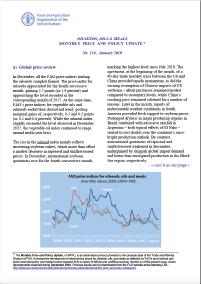
Oilseeds, Oils and Meals. Monthly Price and Policy Update No.114, January 2019
13/09/2019
In December, all the FAO price indices trailing the oilseeds complex firmed. The price index for oilseeds appreciated for the fourth successive month, gaining 2.7 points (or 1.9 percent) and approaching the level recorded in the corresponding month of 2017. At the same time, FAO’s price indices for vegetable oils and oilmeals ended their downward trend, posting marginal gains of, respectively, 0.3 and 0.5 points (or 0.2 and 0.4 percent). While the oilmeal index slightly exceeded the level observed in December 2017, the vegetable oil index continued to range around multi-year lows.
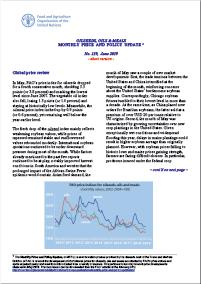
Oilseeds, Oils and Meals. Monthly Price and Policy Update No.119, June 2019
13/09/2019
In May, FAO’s price index for oilseeds dropped for a fourth consecutive month, shedding 5.3 points (or 3.8 percent) and marking the lowest level since June 2007. The vegetable oil index also fell, losing 1.3 points (or 1.0 percent) and staying at historically low levels. Meanwhile, the oilmeal price index inched up by 0.9 points (or 0.6 percent), yet remaining well below the year-earlier level.
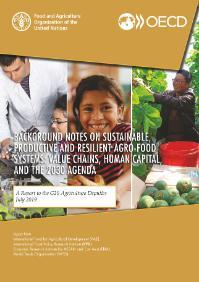
Background Notes on Sustainable, Productive and Resilient Agro-Food Systems: Value chains, human capital, and the 2030 Agenda
13/09/2019
Agricultural production more than tripled between 1960 and 2015, owing in part to productivity-enhancing technologies and a significant expansion in the use of land, water, and other natural resources for agricultural purposes. Today, more than ever, agriculture faces multiple and complex challenges. It has to provide sufficient, safe, and nutritious food to meet boosting demand by a growing and progressively more prosperous population, and ensure food security for all. Prepared to support the G20 Presidency of Japan and the G20 Agriculture Deputies, these three background notes provide an overview on the following interlinked issues: (i) the policy challenges for strengthening the participation of farmers into modern value chains and promoting value addition, inclusion, sustainability and rural economic growth; (ii) the need for a transformation in the skillset of agricultural workers and a renewed focus on human capital development in agriculture, and (iii) the contribution of agriculture to the realization of the 2030 Agenda for Sustainable Development.
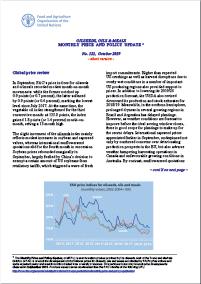
Oilseeds, Oils and Meals. Monthly Price and Policy Update No.123, October 2019
13/09/2019
In September, FAO’s price indices for oilseeds and oilmeals recorded modest month-on-month movements: while the former notched up 0.9 points (or 0.7 percent), the latter softened by 0.9 points (or 0.6 percent), marking the lowest level since July 2017. At the same time, the vegetable oil index strengthened for the third consecutive month: at 135.8 points, the index gained 1.8 points (or 1.4 percent) month-on- month, setting a 13-month high.
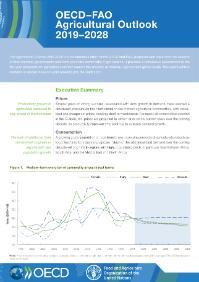
OECD-FAO Agricultural Outlook 2019-2028 - Executive Summary
13/09/2019
The Agricultural Outlook 2019-2028 is a collaborative effort of the Organisation for Economic Co-operation and Development (OECD) and the Food and Agriculture Organization (FAO) of the United Nations. It brings together the commodity, policy and country expertise of both organisations as well as input from collaborating member countries to provide an annual assessment of the prospects for the coming decade of national, regional and global agricultural commodity markets. This year's Special Feature will focus on agricultural development in Latin America and the Caribbean.
